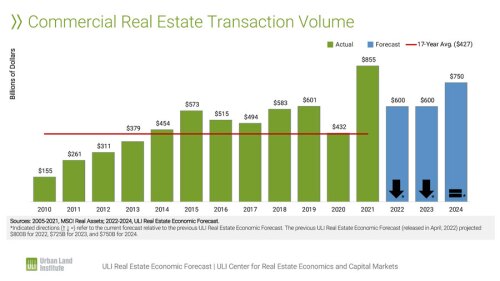
From left to right: Lee Menifee, managing director, PGIM Real Estate; Tom Errath, managing director, Harrison Street; and Ben Breslau, managing director, JLL Americas Research, speaking at the 2021 ULI Fall Meeting. On video at right is Dr. Kenneth Rose, chairman of the Fisher Center for Real Estate and Urban Economics at the University of California, Berkeley.
Despite a forecast for higher inflation and rising interest rates, experts continue to have a favorable view on returns and performance for commercial real estate. However, the high tide of the improving economy is not raising all boats to the same level. There remains a clear bifurcation across and within property sectors.
The Fall 2021 ULI Real Estate Economic Forecast for 2021 to 2023 reveals a bit of a mixed bag on key economic indicators. On the positive side, the economists and analysts surveyed predict solid gross domestic product (GDP) and job growth. On the flip side, there are expectations for higher inflation and moderate increases in interest rates. Both inflation and interest rates provide important context for commercial real estate performance, rent growth, cap rates, and transaction volume.
On Knowledge Finder: Access a discussion of the forecast on demand.
One of the big questions for the industry is where cap rates and prices are headed, and bifurcation in the market is very evident in both. “Some of the transient value in real estate has come from the very low cost of debt. Leverage matters. So, if interest rates go up 100 or 150 basis points on the 10-year, it’s hard to see cap rates not moving up some,” said panelist Kenneth Rosen, chairman of Rosen Consulting Group and chairman of the Fisher Center for Real Estate and Urban Economics.
Others believe that capital inflows and investor demand could provide a counterweight that could keep pressure on cap rates. “The tailwind in terms of favorability of real estate despite all of the challenges in the macro environment will accelerate, not decelerate. So we actually think cap rates will hold pretty tight, if not decline in some areas,” said panelist Ben Breslau, managing director, Americas Research, at JLL.
The forecast for National Council of Real Estate Investment Fiduciaries (NCREIF) cap rates is relatively stable, declining from an average of 4.4 percent in 2021 to 4.3 percent for 2022 and 2023. However, some industrial assets are selling for cap rates of 3.5 percent, while retail properties are above 7 percent in some cases.
Predictions for property price increases based on the RCA Commercial Property Price Index call for a 10 percent jump this year, followed by rates of 7 percent in 2022 and 6 percent in 2023. “With the benefit of some real-time data that a lot of us are getting, that 10 percent number is looking very conservative,” said panelist Lee Menifee, a managing director at PGIM Real Estate and head of Americas Investment Research. Although when you look at the composition, that average is very misleading, he added.
Industrial and multifamily continue to outperform the market in rent growth. The ULI Forecast predicts that each will post annual rent growth of 5 percent this year. In contrast, rent growth for retail is predicted to be 0.6 percent and office –1.5 percent.
In addition, alternative assets have experienced strong rent growth over the past couple of years, and that is clearly helping drive performance, noted panelist Thomas Errath, a managing director at Harrison Street Real Estate.
“However, there is a bit of a supply-and-demand factor that is continuing to drive cap rates low,” he said. Investors are looking to buy trophy assets in many categories such as life sciences, student housing, and self-storage, he added.
Investor demand is propelling a rebound in transaction volume. The ULI Forecast expects transaction volume to rise to $600 billion in both 2022 and 2023, which is near 2019 peak levels. Some view core assets as “bond-like” alternatives, while others are willing to take on more opportunistic risk. “It’s a time where there’s lots out there to buy, but you have to have more courage possibly to buy the contrarian stuff,” Rosen said.
Highlights of the semiannual survey of economists and analysts include the following:
- GDP growth will remain strong at 5.7 percent for 2021 and will slow to 2.5 percent in 2023.
- Inflation is expected to jump to 4.3 percent this fall and then recede to 3 percent in 2022 and 2.4 percent in 2023, which is on par with 2019 levels.
- The 10-year interest rate is forecast to climb a modest 65 basis points to reach 2.25 percent in 2023.
- Transaction volumes continue to rise with $515 billion projected for 2021, then moving higher to $600 billion in 2022 and 2023.
- Expectations for NCREIF total returns are buoyant, rising to 8 percent in 2021 and holding steady at 7 percent in 2022 and 2023.



